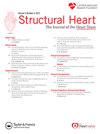术后经食管超声心动图评价手术左心耳排除:特征和成功的预测因素
IF 2.8
Q3 CARDIAC & CARDIOVASCULAR SYSTEMS
引用次数: 0
摘要
背景:越来越多的证据表明,手术左心房附件(LAA)排除可降低房颤患者的卒中风险。先前较早的研究表明LAA排除通常是不完整的,但很少有经食管超声心动图(TEE)数据存在评估LAA残余。方法我们分析了121例可用的术后TEE患者,这些患者通过手术切除(SE)、唇裂闭塞(AO)或虎爪闭塞(TO)来排除LAA。TEE图像评估LAA残留深度、残留血流、可见缝合线、血栓或果胶。LAA排除成功定义为在所有可用成像角度深度超过LAA开口1 cm的残余。结果左心耳排除成功率为99/121(82%)。成功率在数字上有所不同,但在统计上与技术无关;SE、AO、TO组分别为73/85(86%)、22/29(76%)、4/7(57%)。与AO组(0.68±0.38和0.81±0.49)和to组(0.69±0.30和0.83±0.40)相比,SE组的平均和最大(cm)残余深度(0.56±0.32和0.65±0.38)相近。LAA残余血流率分别为4.4% (SE)、15.0% (AO)和20.0% (TO)。果胶残留率分别为18.8% (SE)、13.8% (AO)和14.3% (TO);SE组8%可见缝线。SE组2例出现血栓。在多变量模型中,糖尿病和心力衰竭预测最大LAA深度。结论手术后TEE检查LAA残体按现行标准失败率较高。需要更多的数据来评估LAA残余特征的临床相关性。本文章由计算机程序翻译,如有差异,请以英文原文为准。

Postoperative Transesophageal Echocardiographic Evaluation of Surgical Left Atrial Appendage Exclusion: Characterization and Predictors of Success
Background
Mounting evidence suggests surgical left atrial appendage (LAA) exclusion reduces stroke risk in patients with atrial fibrillation. Prior older research suggests that LAA exclusion is often incomplete, but few transesophageal echocardiogram (TEE) data exist evaluating LAA remnants.
Methods
We analyzed 121 patients with an available postoperative TEE who underwent LAA exclusion by surgical excision (SE), AtriClip occlusion (AO), or Tiger Paw occlusion (TO). TEE images were assessed for LAA remnant depths, presence of flow into remnant, and visible suture, thrombus, or pectinate. Successful LAA exclusion was defined as a remnant with depth past LAA ostium <1 cm in all available imaging angles.
Results
Left atrial appendage exclusion was successful in 99/121 (82%) patients. Success varied numerically but not statistically by technique; 73/85 (86%), 22/29 (76%), 4/7 (57%) in the SE, AO, and TO groups, respectively. SE group had similar mean and max (cm) remnant depths (0.56 ± 0.32 and 0.65 ± 0.38) compared to the AO group (0.68 ± 0.38 and 0.81 ± 0.49) and TO group (0.69 ± 0.30 and 0.83 ± 0.40). Flow into LAA remnant was seen in 4.4% (SE), 15.0% (AO), and 20.0% (TO). Residual pectinate was seen in 18.8% (SE), 13.8% (AO), and 14.3% (TO); 8% in SE group had visible suture. Thrombus was seen in 2 cases within the SE group. In multivariable models, diabetes and heart failure predicted max LAA depth.
Conclusions
Postoperative TEE examination of LAA remnants revealed a relatively high failure rate by current standards. More data are needed to evaluate the clinical relevance of LAA remnant characteristics.
求助全文
通过发布文献求助,成功后即可免费获取论文全文。
去求助
来源期刊

Structural Heart
Medicine-Cardiology and Cardiovascular Medicine
CiteScore
1.60
自引率
0.00%
发文量
81
 求助内容:
求助内容: 应助结果提醒方式:
应助结果提醒方式:


